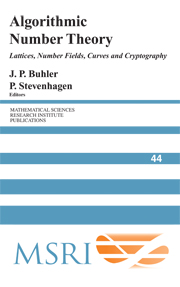Book contents
- Frontmatter
- Contents
- Preface
- Solving the Pell equation
- Basic algorithms in number theory
- Smooth numbers and the quadratic sieve
- The number field sieve
- Four primality testing algorithms
- Lattices
- Elliptic curves
- The arithmetic of number rings
- Smooth numbers: computational number theory and beyond
- Fast multiplication and its applications
- Elementary thoughts on discrete logarithms
- The impact of the number field sieve on the discrete logarithm problem in finite fields
- Reducing lattice bases to find small-height values of univariate polynomials
- Computing Arakelov class groups
- Computational class field theory
- Protecting communications against forgery
- Algorithmic theory of zeta functions over finite fields
- Counting points onvarieties over finite fields of small characteristic
- Congruent number problems and their variants
- An introduction to computing modular forms using modular symbols
The number field sieve
Published online by Cambridge University Press: 30 May 2025
- Frontmatter
- Contents
- Preface
- Solving the Pell equation
- Basic algorithms in number theory
- Smooth numbers and the quadratic sieve
- The number field sieve
- Four primality testing algorithms
- Lattices
- Elliptic curves
- The arithmetic of number rings
- Smooth numbers: computational number theory and beyond
- Fast multiplication and its applications
- Elementary thoughts on discrete logarithms
- The impact of the number field sieve on the discrete logarithm problem in finite fields
- Reducing lattice bases to find small-height values of univariate polynomials
- Computing Arakelov class groups
- Computational class field theory
- Protecting communications against forgery
- Algorithmic theory of zeta functions over finite fields
- Counting points onvarieties over finite fields of small characteristic
- Congruent number problems and their variants
- An introduction to computing modular forms using modular symbols
Summary
We describe the main ideas underlying integer factorization using the number field sieve.
The number field sieve is a factoring algorithm that tries to factor a hard composite number by exploiting factorizations of smooth numbers in a well-chosen algebraic number field. It is similar in nature to the quadratic sieve algorithm, but the underlying number theory is less elementary, and the actual implementation involves a fair amount of optimization of the various parameters.
The key idea of the algorithm, the use of smooth numbers in number rings different from , was proposed in 1988 by Pollard. Many people have contributed theoretical and practical improvements since then. An excellent reference for many of the details left out in this paper is [Lenstra and Lenstra 1993]. It contains complete bibliography of the early years of the number field sieve, as well as original contributions by most of the main developers of the algorithm.
Among the successes of the algorithm are the 2005 factorization of the 663-bit RSA challenge number into a product of two primes of 100 decimal digits each, and the factorization in 2006 of the 275-digit Cunningham number.
Information
- Type
- Chapter
- Information
- Algorithmic Number TheoryLattices, Number Fields, Curves and Cryptography, pp. 83 - 100Publisher: Cambridge University PressPrint publication year: 2008
